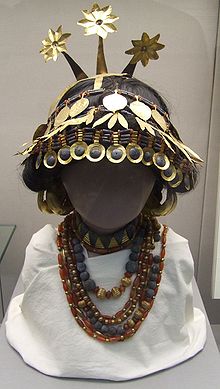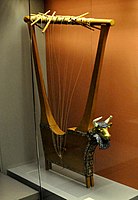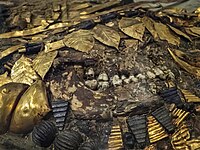Puabi
| Puabi 𒅤𒀜 | |
|---|---|
| Queen of Ur | |
 | |
| Reign | fl. c. 2600 BCE |
| House | First Dynasty of Ur |


Puabi (
Tomb of Puabi
Objects in the Tomb
The number of grave goods that Woolley uncovered in Puabi's tomb was staggering. They included a heavy, golden headdress made of golden leaves, rings and plates; a superb lyre (see Lyres of Ur) complete with a golden and lapis lazuli-encrusted bearded bull's head; a profusion of gold tableware; golden, carnelian, and lapis lazuli cylindrical beads used in extravagant necklaces and belts; a chariot adorned with lioness heads in silver, and an abundance of silver, lapis lazuli, and golden rings and bracelets, as well as her headdress, a belt made of gold rings, carnelian and lapis beads, and other various rings and earrings. Puabi's headdress drew inspiration from nature in its floral motifs and is made up of gold ribbons and leaves, lapis and carnelian beads, and gold flowers.[9]
The "Death Pit"
A number of "death pits" were also found outside of the chambers as well as above Puabi's chamber, raising questions about the initial attribution of the death pits to Puabi specifically.[10] The largest and most well-known death pit held 74 attendants, 6 men, and 68 women, all adorned with various gold, silver, and lapis decoration, and one woman who appeared to be more elaborately adorned than the others.[11] She was buried with 52 attendants: servants, guards, lions, a horse, a chariot, and several other bodies—retainers who were suspected by excavator Leonard Woolley to have poisoned themselves (or to have been poisoned by others) to serve their mistress in the next world. In Puabi's chamber, the remains of three other women were found, and these personal servants had minor adornments of their own. The pit found above Puabi's chamber contained 21 attendants, an elaborate harp or lyre, a chariot, and what was left of a large chest of personal grooming items. Due to the location of the pits and general lack of evidence, it is largely unclear whether the death pits may be directly linked to Puabi.[10]
Theories of cause of death
Evidence derived from CAT scans through the
Remains
Puabi's physical remains, including pieces of the badly damaged skull, are kept in the
Artifacts from tomb PG 800
-
Queen Puabi's Lyre, one of the Lyres of Ur, Ur Royal Cemetery
-
Inlay with two standing goats, Ur, Tomb PG 800
-
Silver lioness head finial for the arm of a chair with shell and lapis lazuli inset eyes, recovered from the royal cemetery of Ur 2550–2450 BCE, from the death pit at the entrance Puabi's chamber[19]
-
Sumerian fluted goblet from the tomb of Queen Puabi, Electrum, 2500 BCE
-
Lapis lazuli cylinder seal recovered from tomb PG 800, inscription U-bara-ge[20]
-
Young attendant from Puabi's death pit, wearing gold headdress and jewelry of gold, lapis lazuli, carnelian, and shell
References
- ^ British Museum notice WA 121544
- ISBN 9781136219115.
- ISBN 9780924171550.
- ISBN 9780226144672.
- ^ ISBN 978-1-58839-043-1.
- ^ "Queen Puabi's Headdress from the Royal Cemetery at Ur - Penn Museum". www.penn.museum. Retrieved 2019-03-28.
- ^ Durn, Sarah, The Most Lavish Mesopotamian Tomb Ever Found Belongs to a Woman, Atlas Obscura, February 10, 2022 with an image of adornment found on Puabi
- ^ Woolley, Leonard (1934). Ur Excavations II, The Royal Cemetery. London-Philadelphia. p. 73 & ss.
- ^ Hafford, William B. (Spring 2018). "A Spectacular Discovery: Burials Simple and Splendid". Expedition: 62–63.
- ^ a b Hafford, William B. (Spring 2018). "A Spectacular Discovery: Burials Simple and Splendid". Expedition: 65.
- ^ "The Death Pit". Retrieved 2019-03-28.
- ^ Baadsgaard, A., Monge, J., Cox, S., & Zettler, R. L. (2012). Bludgeoned, Burned, and Beautified: Reevaluating Mortuary Practices in the Royal Cemetery of Ur. Sacred killing: the archaeology of sacrifice in the ancient Near East (pp. 125-158). Winona Lake, Ind.: Eisenbrauns.
- ISBN 9780691166469.
- ^ British Museum notice WA 121544
- ISBN 9781136219115.
- ISBN 9780924171550.
- ISBN 9781119025542.
- ^ Seal and transcription: "CDLI-Archival View". cdli.ucla.edu.
- ^ B. Ed., Illinois State University. "Artifacts of the Royal Cemetery of Ur". ThoughtCo.
- ISBN 978-0-924171-54-3.
Sources
- "Shub-Ad of Ur". Dinner party Database. Brooklyn Museum. 2007-01-29. Retrieved 2009-09-27.
- White, Anne Terry (1941). Lost worlds: Adventures in Archaeology. Random House. pp. 300–303.
- Woolley, Sir Leonard (1950). Ur of the Chaldees: a Record of Seven Years of Excavation (Edition: 2 ed.). Penguin Books.
External links
- Queen Puabi (Penn Museum)
- Plan of Queen Puabi's gravesite.
- Royal Tombs of Ur at the University of Pennsylvania Museum
- Jane Hickman: "Beauty Through the Ages" Jewelry: Worn to Adorn, lecture at the Penn Museum, published on Youtube 16 November 2011


![Cylinder seal of Queen Puabi, found in her tomb and inscribed as 𒅤𒀜 𒊩𒌆Pu-abi Nin "Queen Puabi".[14][15][16] The last word "𒊩𒌆" may be pronounced as Nin "lady" or Eresh "queen".[17][18]](http://upload.wikimedia.org/wikipedia/commons/thumb/2/20/Flickr_-_Nic%27s_events_-_British_Museum_with_Cory_and_Mary%2C_6_Sep_2007_-_185.jpg/200px-Flickr_-_Nic%27s_events_-_British_Museum_with_Cory_and_Mary%2C_6_Sep_2007_-_185.jpg)


![Silver lioness head finial for the arm of a chair with shell and lapis lazuli inset eyes, recovered from the royal cemetery of Ur 2550–2450 BCE, from the death pit at the entrance Puabi's chamber[19]](http://upload.wikimedia.org/wikipedia/commons/thumb/d/dc/Silver_Lion%27s_Head_Finial_for_the_arm_of_a_chair_with_shell_and_lapis_lazuli_inset_eyes_recovered_from_the_royal_cemetery_of_Ur_2550-2450_BCE.jpg/150px-Silver_Lion%27s_Head_Finial_for_the_arm_of_a_chair_with_shell_and_lapis_lazuli_inset_eyes_recovered_from_the_royal_cemetery_of_Ur_2550-2450_BCE.jpg)

![Lapis lazuli cylinder seal recovered from tomb PG 800, inscription U-bara-ge[20]](http://upload.wikimedia.org/wikipedia/commons/thumb/6/66/Lapis_Lazuli_Cylinder_Seal_recovered_from_the_royal_cemetery_of_Ur%2C_Iraq_2550-2450_BCE.jpg/200px-Lapis_Lazuli_Cylinder_Seal_recovered_from_the_royal_cemetery_of_Ur%2C_Iraq_2550-2450_BCE.jpg)
